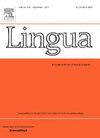普通话接触诱发进化的动机与局限——以海南闽方言接触中的小灵君华为例
IF 1.3
3区 文学
0 LANGUAGE & LINGUISTICS
引用次数: 0
摘要
语音结构与祖先语言的对应模式是确定汉语方言遗传分类的重要标准。小陵军话作为普通话方言,由于与海南闽方言的接触,其声母[t]和[x]发生了变化。原始[x]最初通过模仿邻近方言的音标值而分裂,挑战语音结构。因此,初始系统中的相关音素进行了重组和对比模式的重建,最终保留了普通话的音系框架。孝陵军华的结构调整受到内外因素的双重影响。对内,他们受到普通话语音规则的制约,而对外,方言相对较高的社会地位和说话者的自我认同发挥了作用。这双重因素促使小陵保持了其普通话音系结构,从而保证了其遗传分类的稳定性。本文章由计算机程序翻译,如有差异,请以英文原文为准。
The motivations and limits of Mandarin contact-induced evolution: A case study of Xiaoling Junhua in contact with Min dialects in Hainan
The correspondence patterns between phonological structures and ancestral languages are crucial criteria for determining the genetic classification of Chinese dialects. As a Mandarin dialect, Xiaoling Junhua has undergone changes in the initials [tʰ] and [x] due to contact with Hainan Min dialects. The original [x] initial splits by imitating the phonetic values of neighboring dialects, challenging the phonological structure. Consequently, the related phonemes in the initial system underwent reorganization and the reestablishment of contrast patterns, ultimately preserving the Mandarin phonological framework. The structural adjustments in Xiaoling Junhua were influenced by both internal and external factors. Internally, they were constrained by the phonological rules of Mandarin, while externally, the dialect’s relatively high social status and the speakers’ self-identity played a role. These dual factors prompted Xiaoling to maintain its Mandarin phonological structure, thereby ensuring the stability of its genetic classification.
求助全文
通过发布文献求助,成功后即可免费获取论文全文。
去求助
来源期刊

Lingua
Multiple-
CiteScore
2.50
自引率
9.10%
发文量
93
审稿时长
24 weeks
期刊介绍:
Lingua publishes papers of any length, if justified, as well as review articles surveying developments in the various fields of linguistics, and occasional discussions. A considerable number of pages in each issue are devoted to critical book reviews. Lingua also publishes Lingua Franca articles consisting of provocative exchanges expressing strong opinions on central topics in linguistics; The Decade In articles which are educational articles offering the nonspecialist linguist an overview of a given area of study; and Taking up the Gauntlet special issues composed of a set number of papers examining one set of data and exploring whose theory offers the most insight with a minimal set of assumptions and a maximum of arguments.
 求助内容:
求助内容: 应助结果提醒方式:
应助结果提醒方式:


